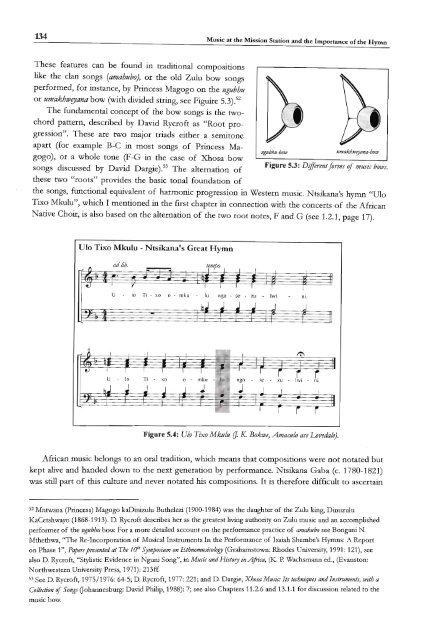South African Choral Music (Amakwaya): Song, Contest and the ...
South African Choral Music (Amakwaya): Song, Contest and the ...
South African Choral Music (Amakwaya): Song, Contest and the ...
You also want an ePaper? Increase the reach of your titles
YUMPU automatically turns print PDFs into web optimized ePapers that Google loves.
134 <strong>Music</strong> at <strong>the</strong> Mission Station <strong>and</strong> <strong>the</strong> Importance of<strong>the</strong> Hymn<br />
These features can be found in traditional composit1ons<br />
like <strong>the</strong> clan songs (amahubo), or <strong>the</strong> old Zulu bow songs<br />
performed, for instance, by Princess Magogo on <strong>the</strong> ugubhu<br />
or umakhwryana bow (with divided string, see Figuire 5.3).52<br />
The fundamental concept of <strong>the</strong> bow songs is <strong>the</strong> twochord<br />
pattern, described by David Rycroft as "Root progression".<br />
These are two major triads ei<strong>the</strong>r a semitone<br />
apart (for example B-C in most songs of Princess Magogo),<br />
or a whole tone (F-G in <strong>the</strong> case of Xhosa bow<br />
songs discussed by David Dargie).53 The alternation of<br />
<strong>the</strong>se two "roots" provides <strong>the</strong> basic tonal foundation of<br />
ugubhu-bow<br />
umakhwryana-bow<br />
Figure 5.3: Differentforms if music bows.<br />
<strong>the</strong> songs, functional equivalent of harmonic progression in Western music. Ntsikana's hymn "UIo<br />
Tixo Mkulu", which I mentioned in <strong>the</strong> fIrst chapter in connection with <strong>the</strong> concerts of <strong>the</strong> <strong>African</strong><br />
Native Choir, is also based on <strong>the</strong> alternation of <strong>the</strong> two root notes, F <strong>and</strong> G (see 1.2.1, page 17).<br />
Ulo Tixo Mkulu - Ntsikana's Great Hymn<br />
ad lib.<br />
U - 10 Ti - xo 0 - mku - lu ngo - se - zu - Iwi nL<br />
Figure 5.4: Ufo Tixo Mku/u (J. K Bokwe, Amacu/o ase Loveda/e).<br />
<strong>African</strong> music belongs to an oral tradition, which means that compositions were not notated but<br />
kept alive <strong>and</strong> h<strong>and</strong>ed down to <strong>the</strong> next generation by performance. Ntsikana Gaba (c. 1780-1821)<br />
was still part of this culture <strong>and</strong> never notated his compositions. It is <strong>the</strong>refore diffIcult to ascertain<br />
52 Mntwana (princess) Magogo kaDinizulu Bu<strong>the</strong>lezi (1900-1984) was <strong>the</strong> daughter of <strong>the</strong> Zulu king, Dinuzulu<br />
KaCetshwayo (1868-1913). D. Rycroft describes her as <strong>the</strong> greatest living authority on Zulu music <strong>and</strong> an accomplished<br />
performer of <strong>the</strong> ugubhu bow. For a more detailed account on <strong>the</strong> performance practice of amahubo see Bongani N.<br />
M<strong>the</strong>thwa, "The Re-Incorporation of <strong>Music</strong>al Instruments In <strong>the</strong> Performance of Isaiah Shembe's Hymns: A Report<br />
on Phase 1", Paperspresented at The trl' Symposium on Ethnomusicology (Grahamstown: Rhodes University, 1991: 121), see<br />
also D. Rycroft, "Stylistic Evidence in Nguni <strong>Song</strong>", in <strong>Music</strong> <strong>and</strong> History in Africa, (K. P. Wachsmann ed., (Evanston:<br />
Northwestern University Press, 1971): 213ff.<br />
53 See D. Rycroft, 1975/1976: 64-5; D. Rycroft, 1977: 221; <strong>and</strong> D. Dargie, Xhosa <strong>Music</strong>: Its techniques <strong>and</strong> Instruments, with a<br />
Collection if <strong>Song</strong>s Oohannesburg: David Philip, 1988): 7; see also Chapters 11.2.6 <strong>and</strong> 13.1.1 for discussion related to <strong>the</strong><br />
music bow.

















